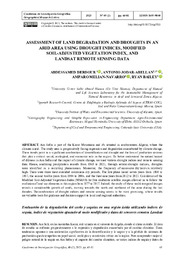Por favor, use este identificador para citar o enlazar este ítem:
https://hdl.handle.net/11000/30994Registro completo de metadatos
| Campo DC | Valor | Lengua/Idioma |
|---|---|---|
| dc.contributor.author | DERDOUR, Abdessamed | - |
| dc.contributor.author | Jordan Abellán, Antonio | - |
| dc.contributor.author | Melian Navarro, Amparo | - |
| dc.contributor.author | Bailey, Ryan | - |
| dc.contributor.other | Departamentos de la UMH::Economía Agroambiental,Ing. Cartográfica y Expresión Gráfica en la Ingeniería | es_ES |
| dc.date.accessioned | 2024-02-05T07:54:15Z | - |
| dc.date.available | 2024-02-05T07:54:15Z | - |
| dc.date.created | 2023-01 | - |
| dc.identifier.citation | Cuadernos de Investigación Geográfica, vol. 49, n.2 (2023) | es_ES |
| dc.identifier.issn | 0211-6820 | - |
| dc.identifier.issn | 1697-9540 | - |
| dc.identifier.uri | https://hdl.handle.net/11000/30994 | - |
| dc.description.abstract | Ain Sefra is part of the Ksour Mountains and it's situated in southwestern Algeria, where the climate is arid. The study area is progressively facing regression and degradation exacerbated by climate change. These trends point to a significant acceleration of desertification and drought and the loss of production systems that play a critical social, ecological, and economic role in the region. To better understand the natural hazard of dryness in Ain Sefra and the impact of climate change, we used various drought indices and remote sensing data. Hence, analyzing precipitation records from 1965 to 2021, through several drought indices, droughts were identified as a recurring phenomenon. Moreover, the frequency of successive dry years is relatively high. There were three most extended continuous dry periods. The first phase lasted seven years from 1980 to 1987, the second twelve years from 1994 to 2006, and the third nine years from 2012 to 2021. Calculation of the Modified Soil-Adjusted Vegetation Index (MSAVI) for five multidate satellite images allowed us to follow the evolution of land use elements in this region from 1977 to 2017. Indeed, the study of these multi-temporal images reveals a considerable growth of sands, moving towards the north and northeast of the zone during the last decades. The combination of drought indices and remote sensing seems to be most promising; whose results are valuable tools for guidance and decision support to local and regional authorities | es_ES |
| dc.description.abstract | Ain Sefr, en las montañas Ksour, está situada en el suroeste de Argelia, donde el clima es árido. El área de estudio se enfrenta progresivamente a la regresión y degradación exacerbada por el cambio climático. Estas tendencias apuntan a una aceleración significativa de la desertificación y la sequía y a la pérdida de sistemas de producción que desempeñan un papel social, ecológico y económico crítico en la región. Para comprender mejor el peligro natural de la sequía en Ain Sefra y el impacto del cambio climático, se varios índices de sequía y datos de teledetección. Al analizar los registros de precipitación desde 1965 hasta 2021, a través de varios índices de sequía, se identificaron las sequías como un fenómeno recurrente. Además, la frecuencia de años secos sucesivos es relativamente alta. Hubo tres períodos secos continuos más prolongados. La primera fase duró siete años, de 1980 a 1987, la segunda doce años, de 1994 a 2006, y la tercera nueve años, de 2012 a 2021. El cálculo del Índice de Vegetación Ajustado al Suelo Modificado (MSAVI) para cinco imágenes satelitales multifecha nos permitió seguir la evolución de los elementos de uso del suelo en esta región desde 1977 hasta 2017. De hecho, el estudio de estas imágenes multitemporales revela un crecimiento considerable de arenas, moviéndose hacia el norte y noreste de la zona durante las últimas décadas. La combinación de índices de sequía y sensores remotos parece ser muy prometedores, pues sus resultados son valiosas herramientas de orientación y apoyo a la decisión de los entes locales y regionales. | es_ES |
| dc.format | application/pdf | es_ES |
| dc.format.extent | 17 | es_ES |
| dc.language.iso | eng | es_ES |
| dc.publisher | Universidad de La Rioja | es_ES |
| dc.rights | info:eu-repo/semantics/openAccess | es_ES |
| dc.rights | Attribution-NonCommercial-NoDerivatives 4.0 Internacional | * |
| dc.rights.uri | http://creativecommons.org/licenses/by-nc-nd/4.0/ | * |
| dc.subject | Ain Sefra | es_ES |
| dc.subject | MSAVI | es_ES |
| dc.subject | Dry climate | es_ES |
| dc.subject | Drought | es_ES |
| dc.subject | Sustainability | es_ES |
| dc.title | ASSESSMENT OF LAND DEGRADATION AND DROUGHTS IN AN ARID AREA USING DROUGHT INDICES, MODIFIED SOIL-ADJUSTED VEGETATION INDEX, AND LANDSAT REMOTE SENSING DATA | es_ES |
| dc.type | info:eu-repo/semantics/article | es_ES |
| dc.relation.publisherversion | http://doi.org/10.18172/cig.5523 | es_ES |

Ver/Abrir:
05_Derdour_p01.pdf
1,4 MB
Adobe PDF
Compartir:
 La licencia se describe como: Atribución-NonComercial-NoDerivada 4.0 Internacional.
La licencia se describe como: Atribución-NonComercial-NoDerivada 4.0 Internacional.
.png)